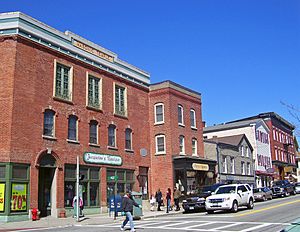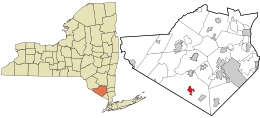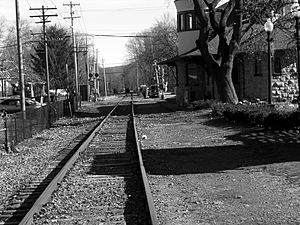Warwick (village), New York facts for kids
Quick facts for kids
Warwick, New York
|
|
|---|---|

Downtown Warwick, 2008
|
|

Location in Orange County and the state of New York.
|
|
| Country | United States |
| State | New York |
| County | Orange |
| Town | Warwick |
| Incorporated | 1867 |
| Area | |
| • Total | 2.43 sq mi (6.29 km2) |
| • Land | 2.43 sq mi (6.28 km2) |
| • Water | 0.00 sq mi (0.01 km2) |
| Elevation | 518 ft (158 m) |
| Population
(2020)
|
|
| • Total | 6,652 |
| • Density | 2,741.96/sq mi (1,058.69/km2) |
| Time zone | UTC-5 (Eastern (EST)) |
| • Summer (DST) | UTC-4 (EDT) |
| ZIP code |
10990
|
| Area code(s) | 845 |
| FIPS code | 36-78355 |
| GNIS feature ID | 0968829 |
Warwick is a small village located in Orange County, New York, in the United States. It is found in the southeastern part of the larger town of Warwick. In 2020, about 6,652 people lived there. Warwick is also part of the big New York City area.
History of Warwick Village
Early Settlement and the American Revolution
Warwick was first settled in the mid-1700s. It started as a farming community. The village was an important stop on the King's Highway. This road connected big cities like Philadelphia and Newburgh, New York.
During the American War for Independence, important events happened here. British General Burgoyne and his army camped near Warwick. This was after they lost the Battle of Saratoga. Also, Martha Washington, the wife of George Washington, stayed at Baird's Tavern. This historic building is still on Main Street today.
The Railroad Era and Growth
In 1859, local business people, including Grinnell Burt, decided to build a railroad. They wanted a way to transport milk and farm products to markets. The Warwick Valley Railroad started in 1860. By 1862, the train line was finished. It was a 10-mile branch of the Erie Railroad.
Many of the brick buildings you see in the village today were built around this time. These include the Dispatch Building and Demerest Hotel. They were made to house train passengers. Later, the Warwick Valley Railroad joined with the Lehigh and Hudson River Railway in 1882. Warwick became the main office for this railway.
Warwick's Role in Freight Transport
The railway yard was first at South Street. Later, a roundhouse and machine shop were built at Elm Street. In 1910, a large complex was built off River Street. The Lehigh and Hudson River Railway was very important. It moved freight between Pennsylvania and a huge rail yard in Maybrook, New York. From Maybrook, goods went to New England over the Poughkeepsie Railroad Bridge.
The railroad was the biggest employer in Warwick. However, as cars became popular, fewer people rode the trains. The last passenger train ran in 1939. The railway's importance declined. After the Poughkeepsie Bridge burned in 1974, the railway went bankrupt. It became part of Conrail in 1976.
Warwick's Small Town Charm
Warwick does not have a direct link to a major highway. Because of this, it did not grow as fast as other towns in Orange County. This helped Warwick keep its small-town feel.
About 130 acres (53 hectares) in the village center are special. They are listed on the National Register of Historic Places. This area is called the Warwick Village Historic District. It includes the oldest building in the village, the 1764 Shingle House. This house is cared for by the Warwick Historical Society. The district also has large cottages built by people from New York City who came for weekend vacations.
Geography of Warwick
Warwick is located at coordinates 41°15′11″N 74°21′24″W. The village covers about 2.2 square miles (5.7 square kilometers) of land.
Roads and Transportation
Two main roads, NY 94 and NY 17A, meet in the village center. These roads connect Warwick to nearby villages like Florida and Greenwood Lake. Other local roads, County Routes 1A, 1B, and 13, also lead into the village.
On the north side of Warwick, you will find St. Anthony Medical Center. Since passenger trains no longer run, the main way to get to New York City is by NJ Transit buses. You can take either the 196 (express) or 197 (local) bus routes.
Surrounding Areas
The border between New York and New Jersey is about 4 miles (6.4 kilometers) west of the village. Several small communities are around Warwick. These include Amity, Bellvale, Wisner, Edenville, Greenwood Forest Farms, Little York, New Milford, Pine Island, and Sterling Forest.
Population of Warwick
Population Growth Over Time
The population of Warwick has changed over the years. Here is a look at how many people have lived in the village during different census years:
| Historical population | |||
|---|---|---|---|
| Census | Pop. | %± | |
| 1870 | 938 | — | |
| 1880 | 1,043 | 11.2% | |
| 1890 | 1,537 | 47.4% | |
| 1900 | 1,735 | 12.9% | |
| 1910 | 2,318 | 33.6% | |
| 1920 | 2,420 | 4.4% | |
| 1930 | 2,443 | 1.0% | |
| 1940 | 2,534 | 3.7% | |
| 1950 | 2,674 | 5.5% | |
| 1960 | 3,218 | 20.3% | |
| 1970 | 3,604 | 12.0% | |
| 1980 | 4,320 | 19.9% | |
| 1990 | 5,984 | 38.5% | |
| 2000 | 6,412 | 7.2% | |
| 2010 | 6,731 | 5.0% | |
| 2020 | 6,652 | −1.2% | |
| U.S. Decennial Census | |||
Demographics in 2000
According to the census from the year 2000, there were 6,412 people living in Warwick. There were 2,523 households, which are groups of people living together in one home. Out of these, 1,619 were families.
The village had about 2,870 people per square mile (1,108 per square kilometer). Most residents, about 92.56%, were white. About 3.26% were black or African American. Other groups included Native American, Asian, and people of two or more races. About 5.68% of the population was Hispanic or Latino.
Household Information
In 2000, 34.0% of households had children under 18 living with them. About 51.6% were married couples. About 9.6% had a female head of household with no husband present. The average household had 2.46 people, and the average family had 3.16 people.
The population was spread out by age. About 26.3% were under 18 years old. About 18.4% were 65 years or older. The average age in the village was 40 years.
See also
 In Spanish: Warwick (villa) para niños
In Spanish: Warwick (villa) para niños



